Coordinated Control of Superconducting Fault Current Limiter and Superconducting Magnetic Energy Storage for Transient Performance Enhancement of Grid-Connected Photovoltaic Generation System
Abstract
:1. Introduction
2. Theoretical Presentation of a Grid-Connected Photovoltaic Generation System
3. Configuration of the Superconducting Fault Current Limiter and Its Effects on the Photovoltaic Generation System
4. Structure, Control and Capacity Design of the Superconducting Magnetic Energy Storage for the Photovoltaic Generation
5. Simulation Studies and Verification
5.1. Modeling and Parameters
5.2. Simulation Study of the Symmetrical Fault
5.3. Simulation Study of the Asymmetrical Fault
6. Optimization Method for the Superconducting Fault Current Limiter–Superconducting Magnetic Energy Storage
- (1)
- 400 V ≤ VDC1-f ≤ 600 V (range of the DC-link voltage)
- (2)
- 0.01 Ω≤ RSC ≤ 5 Ω (range of the SC resistance)
- (3)
- 0.01 H≤ LSC≤ 10 H (range of the SMES coil inductance)
- (4)
- 0.1 A≤ ISMES0 ≤ 2 kA (range of the SMES initial coil current)
- (5)
- 0.5ISMES0 ≤ ISMES ≤ 1.5ISMES0 (range of the SMES coil current)
- (6)
- 0.0001 ≤ KPk, KQk ≤ 100 (range of the SMES power controller gain)
- (7)
- 0.0001 ≤ TPk, TQk ≤ 1 (range of the SMES power controller time constant)
7. Conclusions
- (1)
- The single use of the SFCL has a better effect on limiting the fault current, but weaker effects on the power compensation and DC overvoltage inhibition. The single use of the SMES can provide flexible power compensation, but it has a larger capacity requirement and a weaker effect on improving the voltage sag. In contrast, the coordinated control of the SFCL and the SMES can offer the best comprehensive performance. The combination of without MPPT and with SFCL-SMES can more efficiently improve the PCC voltage sag, inhibit the DC-link overvoltage and alleviate the PV system’s power fluctuation. Thus, the PV system’s robustness against short-circuit faults can be well strengthened.
- (2)
- Regarding the SFCL-SMES, its specific effect on reducing the imbalance in the three-phase fault voltages may have a margin for improvement. As one of the future works, the control of the positive, negative and zero sequence components of the reactive current may be appreciatively introduced, so as to make the SFCL-SMES be able to deal with the asymmetrical fault and mitigate the three-phase imbalance more efficiently.
- (3)
- Since the transient characteristics of the PV generation system will be closely related to the fault type, no matter the SFCL’s effects on the fault current, DC-link overvoltage and PCC voltage sag, or the power requirements for the SMES unit under the symmetrical and asymmetrical faults are different. In the follow-up works, the detailed optimization design of the SFCL-SMES capacity will be carried out, and more different conditions including fault resistance, fault duration, and fault location will be taken into account.
Acknowledgments
Author Contributions
Conflicts of Interest
References
- Kies, A.; Schyska, B.U.; von Bremen, L. Curtailment in a highly renewable power system and its effect on capacity factors. Energies 2016, 9, 510. [Google Scholar] [CrossRef]
- Leccisi, E.; Raugei, M.; Fthenakis, V. The Energy and environmental performance of ground-mounted photovoltaic systems—A timely update. Energies 2016, 9, 622. [Google Scholar] [CrossRef]
- Elserougi, A.; Massoud, A.M.; Abdel-Khalik, A.S.; Ahmed, S. Three-wire bipolar high-voltage direct current line using an existing single-circuit high-voltage alternating current line for integrating renewable energy sources in multiterminal DC networks. IET Renew. Power Gener. 2016, 10, 370–379. [Google Scholar] [CrossRef]
- Baker, K.; Guo, J.; Hug, G.; Li, X. Distributed MPC for efficient coordination of storage and renewable energy sources across control areas. IEEE Trans. Smart Grid 2016, 7, 992–1001. [Google Scholar] [CrossRef]
- Miret, J.; Castilla, M.; Camacho, A.; de Vicuña, L.G.; Matas, G. Control scheme for photovoltaic three-phase inverters to minimize peak currents during unbalanced grid-voltage sags. IEEE Trans. Power Electron. 2012, 27, 4262–4271. [Google Scholar] [CrossRef]
- Gu, B.; Sheng, V.S.; Wang, Z.; Ho, D.; Osman, S.; Li, S. Incremental learning for ν-support vector regression. Neural Netw. 2015, 67, 140–150. [Google Scholar] [CrossRef] [PubMed]
- Zhang, Y.; Sun, X.; Wang, B. Efficient algorithm for k-barrier coverage based on integer linear programming. China Commun. 2016, 13, 16–23. [Google Scholar] [CrossRef]
- Fu, Z.; Sun, X.; Liu, Q.; Zhou, L.; Shu, J. Achieving efficient cloud search services: Multi-keyword ranked search over encrypted cloud data supporting parallel computing. IEICE Trans. Commun. 2015, 98, 190–200. [Google Scholar] [CrossRef]
- Ma, T.; Zhou, J.; Tang, M.; Tian, Y.; Al-Dhelaan, A.; Al-Rodhaan, M.; Lee, S. Social network and tag sources based augmenting collaborative recommender system. IEICE Trans. Inf. Syst. 2015, 98, 902–910. [Google Scholar] [CrossRef]
- Yan, B.; Wang, B.; Zhu, L.; Liu, H.; Liu, Y.; Ji, X.; Liu, D. A novel, stable, and economic power sharing scheme for an autonomous microgrid in the energy internet. Energies 2015, 8, 12741–12764. [Google Scholar] [CrossRef]
- Xia, Z.; Wang, X.; Sun, X.; Wang, Q. A secure and dynamic multi-keyword ranked search scheme over encrypted cloud data. IEEE Trans. Parallel Distr. Syst. 2015, 27, 340–352. [Google Scholar] [CrossRef]
- Fu, Z.; Ren, K.; Shu, J.; Sun, X.; Huang, F. Enabling personalized search over encrypted outsourced data with efficiency improvement. IEEE Trans. Parallel Distr. Syst. 2016, 27, 2546–2559. [Google Scholar] [CrossRef]
- Lee, G.; Kim, H. Green small cell operation of ultra-dense networks using device assistance. Energies 2016, 9, 1065. [Google Scholar] [CrossRef]
- Chen, X.; Yin, X.; Yu, B.; Zhang, Z. Communication channel reconstruction for transmission line differential protection: System arrangement and routing protocol. Energies 2016, 9, 893. [Google Scholar] [CrossRef]
- Fu, Z.; Wu, X.; Guan, C.; Sun, X.; Ren, K. Toward efficient multi-keyword fuzzy search over encrypted outsourced data with accuracy improvement. IEEE Trans. Inf. Forensics Secur. 2016, 11, 2706–2716. [Google Scholar] [CrossRef]
- Xia, Z.; Wang, X.; Zhang, L.; Qin, Z.; Sun, X.; Ren, K. A privacy-preserving and copy-deterrence content-based image retrieval scheme in cloud computing. IEEE Trans. Inf. Forensics Secur. 2016, 11, 2594–2608. [Google Scholar] [CrossRef]
- Yuan, C.; Sun, X.; Lv, R. Fingerprint liveness detection based on multi-scale LPQ and PCA. China Commun. 2016, 13, 60–65. [Google Scholar] [CrossRef]
- Zhou, Z.; Wang, Y.; Jonathan Wu, Q.M.; Yang, C.N.; Sun, X. Effective and efficient global context verification for image copy detection. IEEE Trans. Inf. Forensics Secur. 2017, 12, 48–63. [Google Scholar] [CrossRef]
- Yang, Y.; Blaabjerg, F.; Wang, H. Low-voltage ride-through of single-phase transformerless photovoltaic inverters. IEEE Trans. Ind. Appl. 2014, 50, 1942–1952. [Google Scholar] [CrossRef]
- Coster, E.J.; Myrzik, J.M.A.; Kruimer, B.; Kling, W.L. Integration issues of distributed generation in distribution grids. Proc. IEEE 2011, 99, 28–39. [Google Scholar] [CrossRef]
- Hudson, R.; Heilscher, G. PV grid integration—System management issues and utility concerns. Energy Procedia 2012, 25, 82–92. [Google Scholar] [CrossRef]
- Yang, Y.; Blaabjerg, F. Low voltage ride-through capability of a single-stage single-phase photovoltaic system connected to the low voltage grid. Int. J. Photoenergy 2013, 2013. [Google Scholar] [CrossRef]
- Zhang, W.; Remon, D.; Cantarellas, A.M.; Rodriguez, P. A unified current loop tuning approach for grid-connected photovoltaic inverters. Energies 2016, 9, 723. [Google Scholar] [CrossRef]
- Hao, T.; Feng, G.; Guoqing, H.; Li, G. Low voltage ride through of two-stage photovoltaic inverter with enhanced operational performance. In Proceedings of the 2012 Twenty-Seventh Annual IEEE Applied Power Electronics Conference and Exposition (APEC), Orlando, FL, USA, 5–9 February 2012.
- Moursi, M.S.E.; Xiao, W.; Jim, L.K.J. Fault ride through capability for grid interfacing large scale PV power plants. IET. Renew. Power. Gener. 2013, 7, 1027–1036. [Google Scholar] [CrossRef]
- Bae, Y.; Vu, T.K.; Kim, R.Y. Implemental control strategy for grid stabilization of grid-connected PV system based on German grid code in symmetrical low-to-medium voltage network. IEEE Trans. Energy Convers. 2013, 28, 619–631. [Google Scholar] [CrossRef]
- Mitra, M.; Josep, P.; Vassilios, G.A. Single- and two-stage inverter-based grid-connected photovoltaic power plants with ride-through capability under grid faults. IEEE Trans. Sustain. Energy 2015, 6, 1150–1159. [Google Scholar]
- Neves, F.A.S.; Carrasco, M.; Mancilla-David, F.; Azevedo, G.M.S.; Santos, V.S. Unbalanced grid fault ride-through control for single-stage photovoltaic inverters. IEEE Trans. Power Electron. 2016, 31, 3338–3347. [Google Scholar] [CrossRef]
- Ding, G.; Gao, F.; Tian, H.; Ma, C.; Chen, M.; He, G.; Liu, Y. Adaptive DC-link voltage control of two-stage photovoltaic inverter during low voltage ride-through operation. IEEE Trans. Power Electron. 2016, 31, 4182–4194. [Google Scholar] [CrossRef]
- Tian, H.; Gao, F.; Ma, C. Novel low voltage ride through strategy of single-stage grid-tied photovoltaic inverter with supercapacitor coupled. In Proceedings of the 2012 7th International Power Electronics and Motion Control Conference (IPEMC), Harbin, China, 2–5 June 2012.
- Yang, F.; Yang, L.; Ma, X. An advanced control strategy of PV system for low-voltage ride-through capability enhancement. Sol. Energy 2014, 109, 24–35. [Google Scholar] [CrossRef]
- Rauf, A.M.; Khadkikar, V. Integrated photovoltaic and dynamic voltage restorer system configuration. IEEE Trans. Sustain. Energy 2015, 6, 400–410. [Google Scholar] [CrossRef]
- Hossain, M.K.; Ali, M.H. Transient stability augmentation of PV/DFIG/SG-based hybrid power system by nonlinear control-based variable resistive FCL. IEEE Trans. Sustain. Energy 2015, 6, 1638–1649. [Google Scholar] [CrossRef]
- Hossain, M.K.; Ali, M.H. Transient stability augmentation of PV/DFIG/SG-based hybrid power system by parallel-resonance bridge fault current limiter. Electr. Power Syst. Res. 2016, 130, 89–102. [Google Scholar] [CrossRef]
- Kang, B.-K.; Kim, S.-T.; Bae, S.-H.; Park, J.-W. Effect of a SMES in power distribution network with PV system and PBEVs. IEEE Trans. Appl. Supercond. 2013, 23. [Google Scholar] [CrossRef]
- Kang, B.-K.; Kim, S.-T.; Bae, S.-H.; Park, J.-W. Application of SMES and grid code compliance to wind/photovoltaic generation system. IEEE Trans. Appl. Supercond. 2013, 23. [Google Scholar] [CrossRef]
- Kreeumporn, W.; Ngamroo, I. Optimal superconducting coil integrated into PV generators for smoothing power and regulating voltage in distribution system with PHEVs. IEEE Trans. Appl. Supercond. 2016, 26. [Google Scholar] [CrossRef]
- Ebrahimpour, M.; Vahidi, B.; Hosseinian, S.H. A hybrid superconducting fault current controller for DG networks and microgrids. IEEE Trans. Appl. Supercond. 2013, 23. [Google Scholar] [CrossRef]
- Chen, L.; Deng, C.; Guo, F.; Tang, Y.; Shi, J.; Ren, L. Reducing the fault current and overvoltage in a distribution system with distributed generation units through an active type SFCL. IEEE Trans. Appl. Supercond. 2014, 24. [Google Scholar] [CrossRef]
- Zheng, F.; Deng, C.; Chen, L.; Li, S.; Liu, Y.; Liao, Y. Transient performance improvement of microgrid by a resistive superconducting fault current limiter. IEEE Trans. Appl. Supercond. 2015, 25. [Google Scholar] [CrossRef]
- Xue, S.; Gao, F.; Sun, W.; Li, B. Protection principle for a DC distribution system with a resistive superconductive fault current limiter. Energies 2015, 8, 4839–4852. [Google Scholar] [CrossRef]
- Oliveira, F.; Amorim, A.; Encarnação, L.; Fardin, J.; Orlando, M.; Silva, S.; Simonetti, D. Enhancing LVRT of DFIG by using a superconducting current limiter on rotor circuit. Energies 2016, 9, 16. [Google Scholar] [CrossRef]
- Elshiekh, M.E.; Mansour, D.-E.A.; Azmy, A.M. Improving fault ride-through capability of DFIG-based wind turbine using superconducting fault current limiter. IEEE Trans. Appl. Supercond. 2013, 23. [Google Scholar] [CrossRef]
- Hossain, M.M.; Ali, M.H. Transient stability improvement of doubly fed induction generator based variable speed wind generator using DC resistive fault current limiter. IET Renew. Power Gener. 2016, 10, 150–157. [Google Scholar] [CrossRef]
- Zou, Z.C.; Chen, X.Y.; Li, C.S.; Xiao, X.Y.; Zhang, Y. Conceptual design and evaluation of a resistive-type SFCL for efficient fault ride through in a DFIG. IEEE Trans. Appl. Supercond. 2016, 26. [Google Scholar] [CrossRef]
- Rodríguez, A.; Huerta, F.; Bueno, E.J.; Rodríguez, F.J. Analysis and performance comparison of different power conditioning systems for SMES-based energy systems in wind turbines. Energies 2013, 6, 1527–1553. [Google Scholar] [CrossRef]
- Zhang, N.; Gu, W.; Yu, H.; Liu, W. Application of coordinated SOFC and SMES robust control for stabilizing tie-line power. Energies 2013, 6, 1902–1917. [Google Scholar] [CrossRef]
- Shi, X.; Wang, S.; Yao, W.; Waqar, A.; Zuo, W.; Tang, Y. Mechanism analysis and experimental validation of employing superconducting magnetic energy storage to enhance power system stability. Energies 2015, 8, 656–681. [Google Scholar] [CrossRef]
- Guo, W.; Xiao, L.; Dai, S. Enhancing low-voltage ride-through capability and smoothing output power of DFIG with a superconducting fault-current limiter–magnetic energy storage system. IEEE Trans. Energy Convers. 2012, 27, 277–295. [Google Scholar] [CrossRef]
- Ngamroo, I.; Vachirasricirikul, S. Coordinated control of optimized SFCL and SMES for improvement of power system transient stability. IEEE Trans. Appl. Supercond. 2012, 22. [Google Scholar] [CrossRef]
- Ngamroo, I.; Vachirasricirikul, S. Optimized SFCL and SMES units for multimachine transient stabilization based on kinetic energy control. IEEE Trans. Appl. Supercond. 2013, 23. [Google Scholar] [CrossRef]
- Ngamroo, I.; Karaipoom, T. Cooperative control of SFCL and SMES for enhancing fault ride through capability and smoothing power fluctuation of DFIG wind farm. IEEE Trans. Appl. Supercond. 2014, 24. [Google Scholar] [CrossRef]
- Guo, W.; Zhang, J.; Song, N.; Gao, Z.; Ma, T.; Zhu, Z.; Xu, X.; Li, L.; Wang, Y.; Dai, S.; et al. Overview and development progress of a 1-MVA/1-MJ superconducting fault current limiter-magnetic energy storage system. IEEE Trans. Appl. Supercond. 2016, 26. [Google Scholar] [CrossRef]
- Kou, W.; Wei, D.; Zhang, P.; Xiao, W. A direct phase-coordinates approach to fault ride through of unbalanced faults in large-scale photovoltaic power systems. Electr. Power Compon. Syst. 2015, 43, 902–913. [Google Scholar] [CrossRef]
- Chen, L.; Deng, C.; Zheng, F.; Li, S.; Liu, Y.; Liao, Y. Fault ride-through capability enhancement of DFIG-based wind turbine with a flux-coupling-type SFCL employed at different locations. IEEE Trans. Appl. Supercond. 2015, 25. [Google Scholar] [CrossRef]
- Chen, L.; Zheng, F.; Deng, C.; Li, S.; Li, M.; Liu, H.; Zhu, L.; Guo, F. Application of a modified flux-coupling type superconducting fault current limiter to transient performance enhancement of micro-grid. Physica C 2015, 518, 144–148. [Google Scholar] [CrossRef]
- Deng, C.; Zheng, F.; Chen, L.; Li, M.; Xia, P.; Li, S.; Long, Z.; Zhu, L.; Guo, F. Study of a modified flux-coupling-type superconducting fault current limiter for mitigating the effect of DC short circuit in a VSC-HVDC system. J. Supercond Nov. Magn. 2015, 28, 1525–1534. [Google Scholar] [CrossRef]
- Chen, L.; Tang, Y.; Shi, J.; Chen, N.; Song, M.; Cheng, S.J.; Hu, Y.; Chen, X.S. Influence of a voltage compensation type active superconducting fault current limiter on the transient stability of power system. Physica C 2009, 469, 1760–1764. [Google Scholar] [CrossRef]
- Didier, G.; Bonnard, C.H.; Lubin, T.; Lévêque, J. Comparison between inductive and resistive SFCL in terms of current limitation and power system transient stability. Electr. Power Syst. Res. 2015, 125, 150–158. [Google Scholar] [CrossRef]
- Chen, L.; Chen, H.K.; Yang, J.; Shu, Z.; He, H.; Shu, X. Conceptual design of a high-speed electromagnetic switch for a modified flux-coupling-type SFCL and its application in renewable energy system. SpringerPlus 2016, 5, 771–785. [Google Scholar] [CrossRef] [PubMed]
- Wiseman, J.; Wu, B. Active damping control of a high-power PWM current-source rectifier for line-current THD reduction. IEEE Trans. Ind. Electron. 2005, 52, 758–764. [Google Scholar] [CrossRef]
- Gao, S.; Chau, K.T.; Liu, C.; Wu, D.; Li, J. SMES control for power grid integrating renewable generation and electric vehicles. IEEE Trans. Appl. Supercond. 2012, 22. [Google Scholar] [CrossRef]
- Giroux, P.; Sybille, G.; Osorio, C.; Chandrachood, S. 100-kW Grid-Connected PV Array Demo Detailed Model; MathWorks File Exchange; MathWorks: Natick, MA, USA, 2012. [Google Scholar]
- Ying, X. Review on superconducting fault current limiters. South. Power Syst. Technol. 2015, 9, 1–9. (In Chinese) [Google Scholar]
- Liu, Y.; Tang, Y.; Shi, J.; Shi, X.; Deng, J.; Gong, K. Application of small-sized SMES in an EV charging station with DC bus and PV system. IEEE Trans. Appl. Supercond. 2015, 25. [Google Scholar] [CrossRef]
- Moon, J.F.; Lim, S.H.; Kim, J.C.; Yun, S.Y. Assessment of the impact of SFCL on voltage sags in power distribution system. IEEE Trans. Appl. Supercond. 2011, 21, 2161–2164. [Google Scholar] [CrossRef]
- Zhu, J.; Bao, X.; Yang, B.; Chen, P.; Yang, Y.; Qiu, M. Dynamic simulation test research on power fluctuation compensation using hybrid SMES of YBCO and BSCCO tapes. IEEE Trans. Appl. Supercond. 2012, 22. [Google Scholar] [CrossRef]
- Yang, Y.; Blaabjerg, F.; Zou, Z. Benchmarking of grid fault modes in single-phase grid-connected photovoltaic systems. IEEE Trans. Ind. Appl. 2013, 49, 2167–2176. [Google Scholar] [CrossRef]
- Chen, L.; Zheng, F.; Deng, C.; Li, Z.; Guo, F. Fault ride-through capability improvement of DFIG-based wind turbine by employing a voltage compensation type active SFCL. Can. J. Electr. Comput. Eng. 2015, 38, 132–142. [Google Scholar] [CrossRef]
- Zhou, T.; Sun, W. Optimization of battery–supercapacitor hybrid energy storage station in wind/solar generation system. IEEE Trans. Sustain. Energy 2014, 5, 408–415. [Google Scholar] [CrossRef]
- Moradi, M.H.; Eskandari, M.; Mahdi Hosseinian, S. Operational strategy optimization in an optimal sized smart microgrid. IEEE Trans. Smart Grid 2015, 6, 1087–1095. [Google Scholar] [CrossRef]
- Jiang, P.; Liu, F.; Song, Y. A hybrid multi-step model for forecasting day-ahead electricity price based on optimization, fuzzy logic and model selection. Energies 2016, 9, 618. [Google Scholar] [CrossRef]
- Ahmed, M.S.; Mohamed, A.; Homod, R.Z.; Shareef, H. Hybrid LSA-ANN based home energy management scheduling controller for residential demand response strategy. Energies 2016, 9, 716. [Google Scholar] [CrossRef]

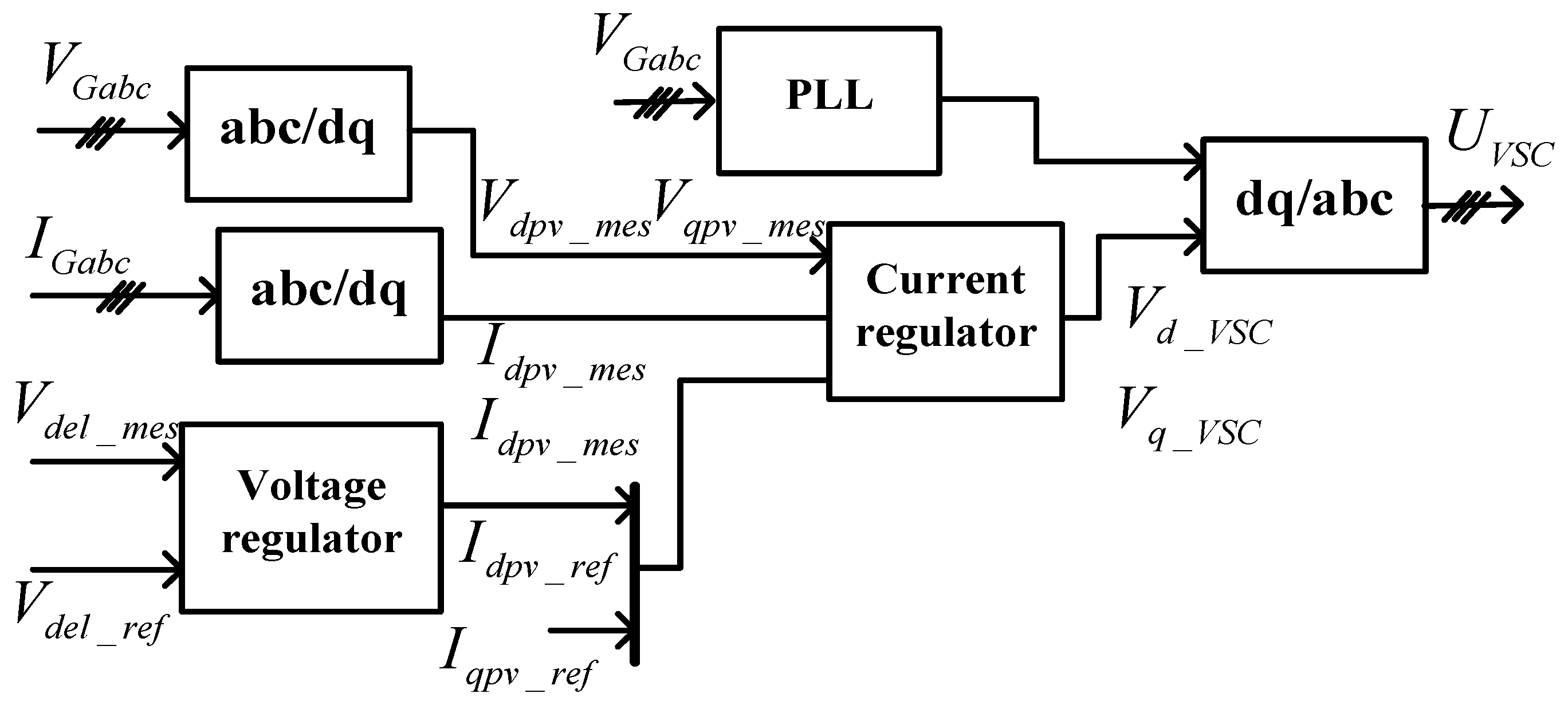
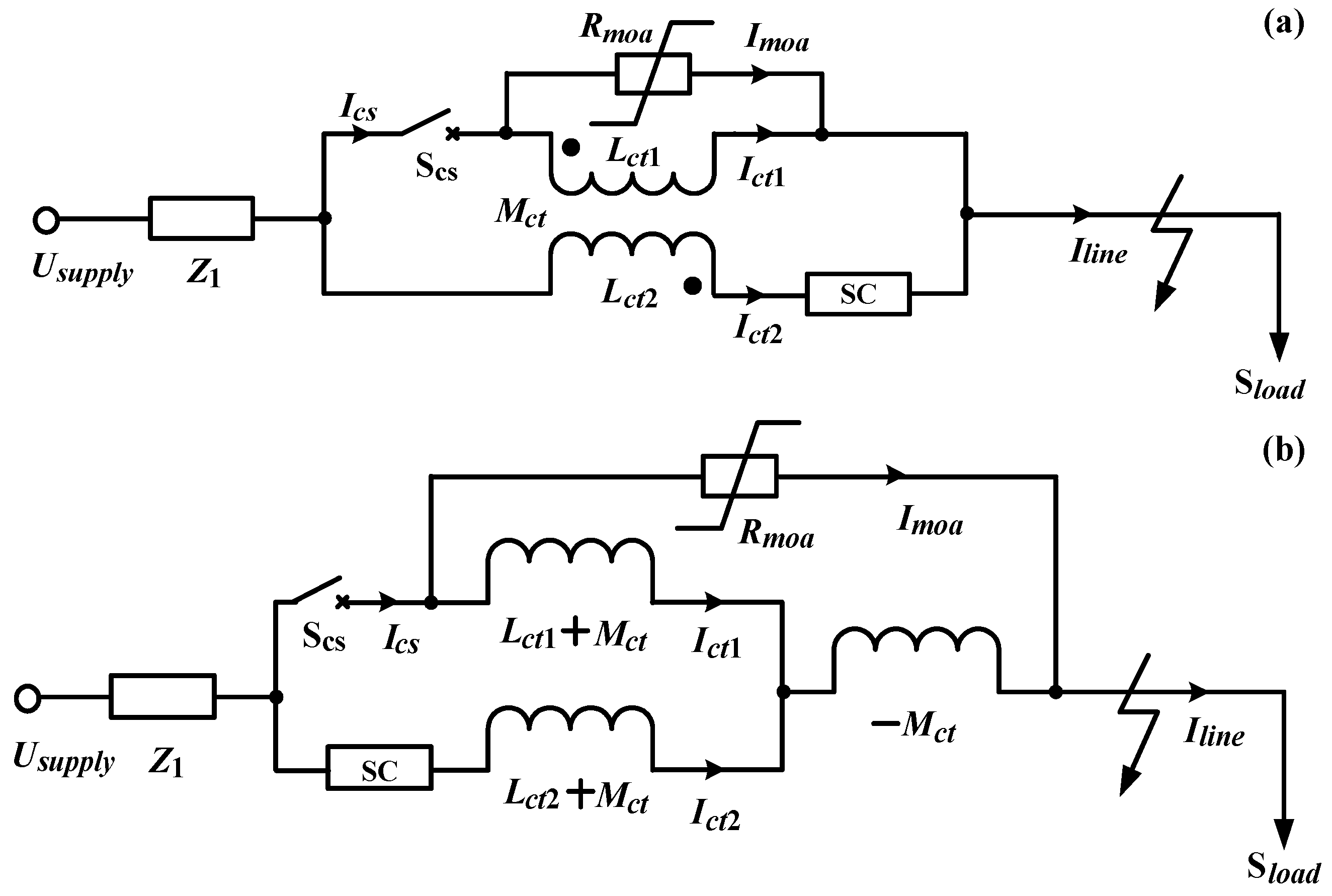

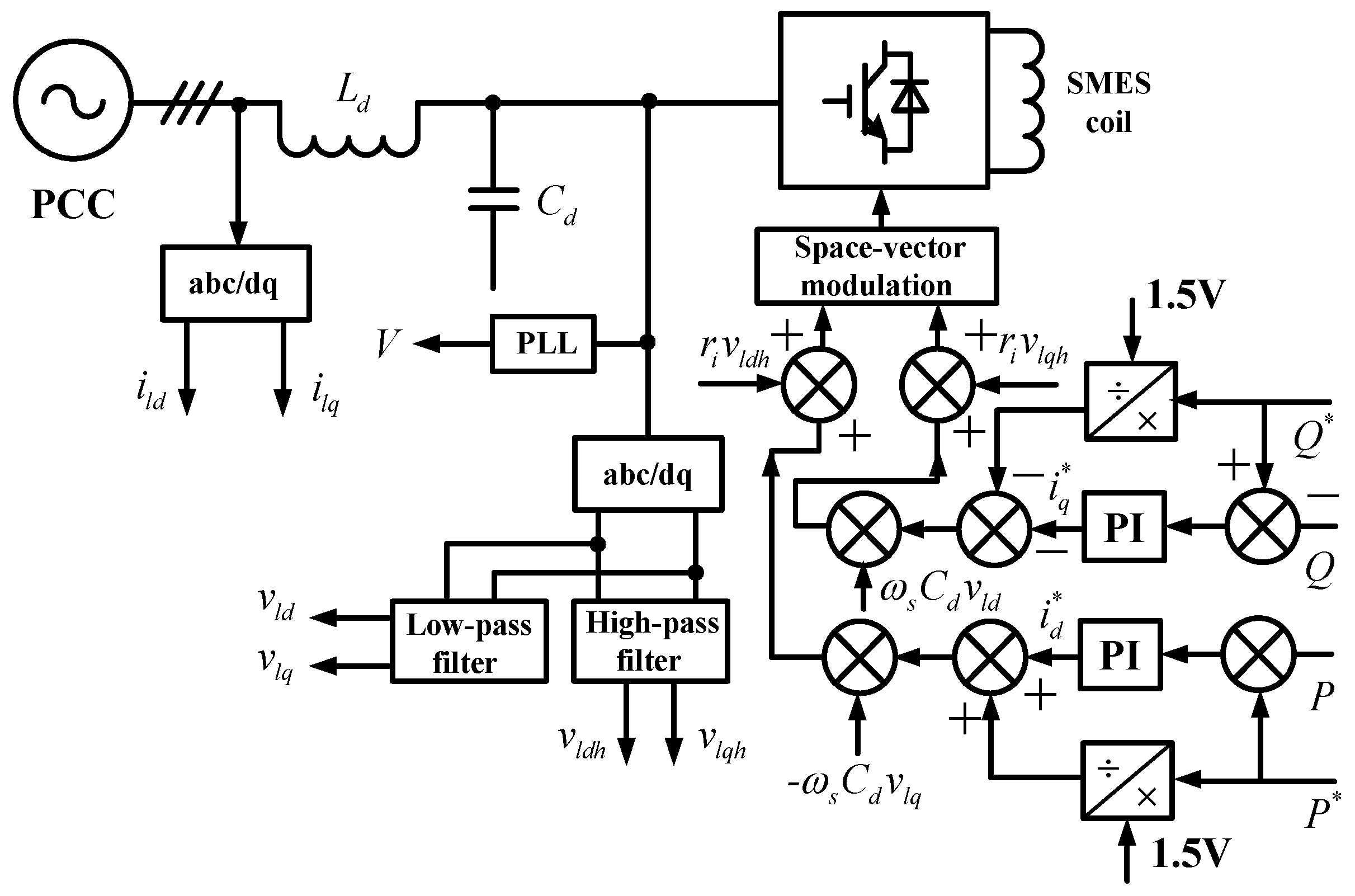

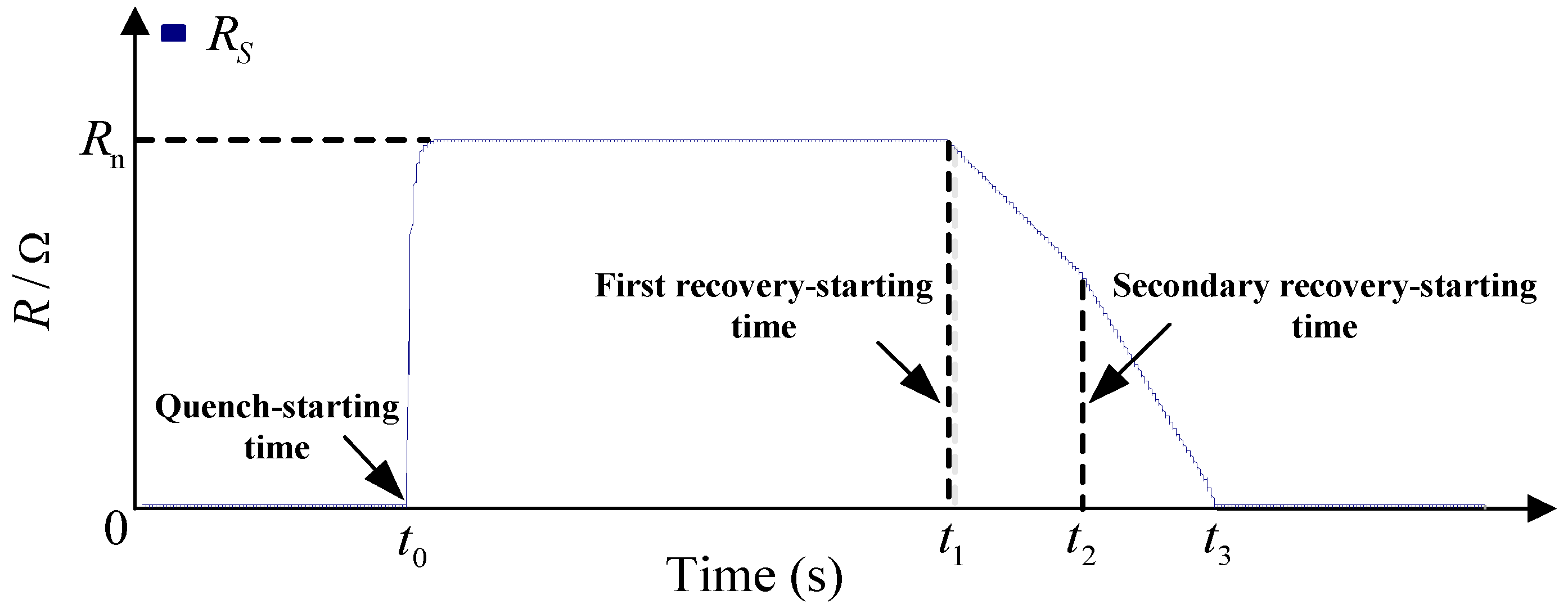

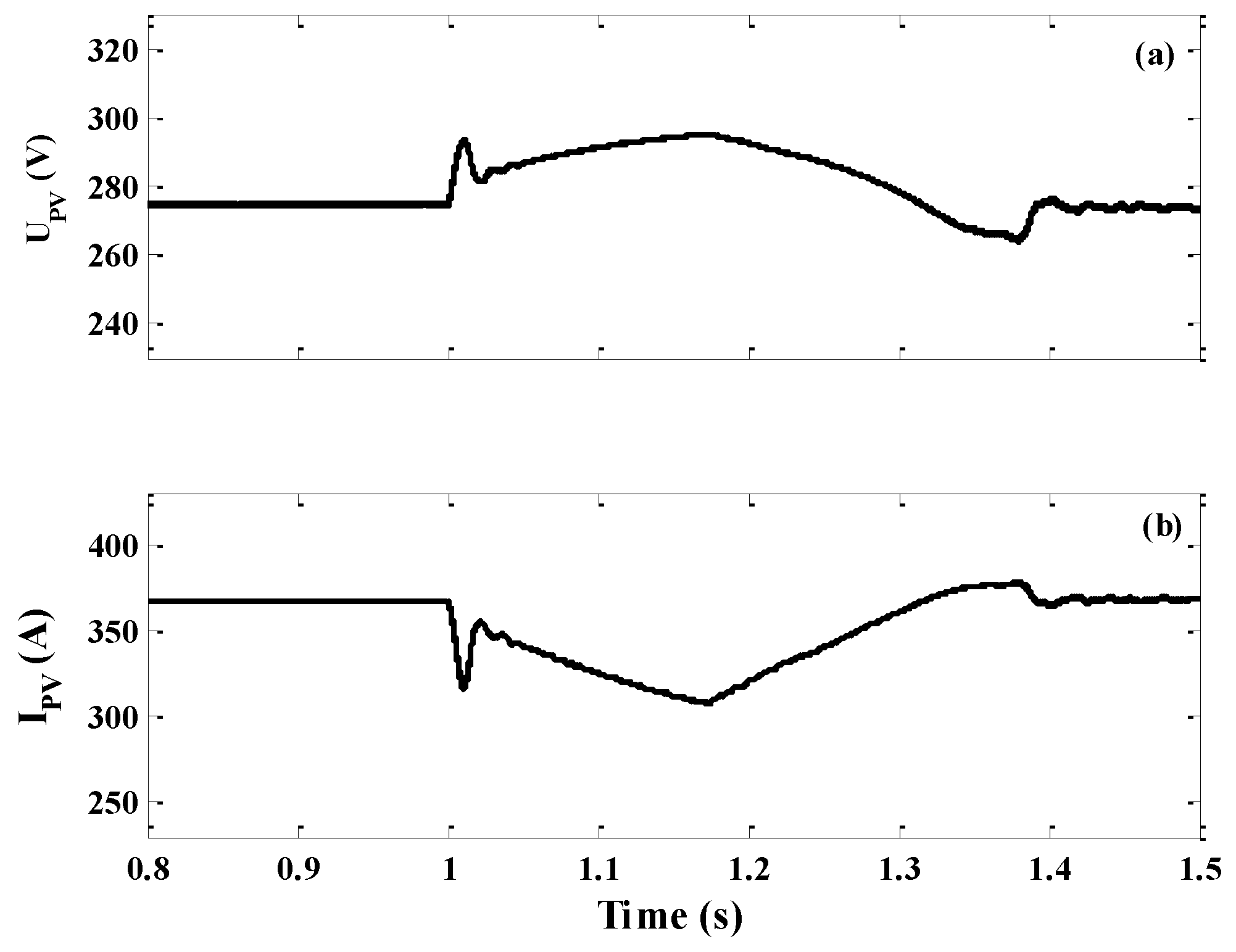

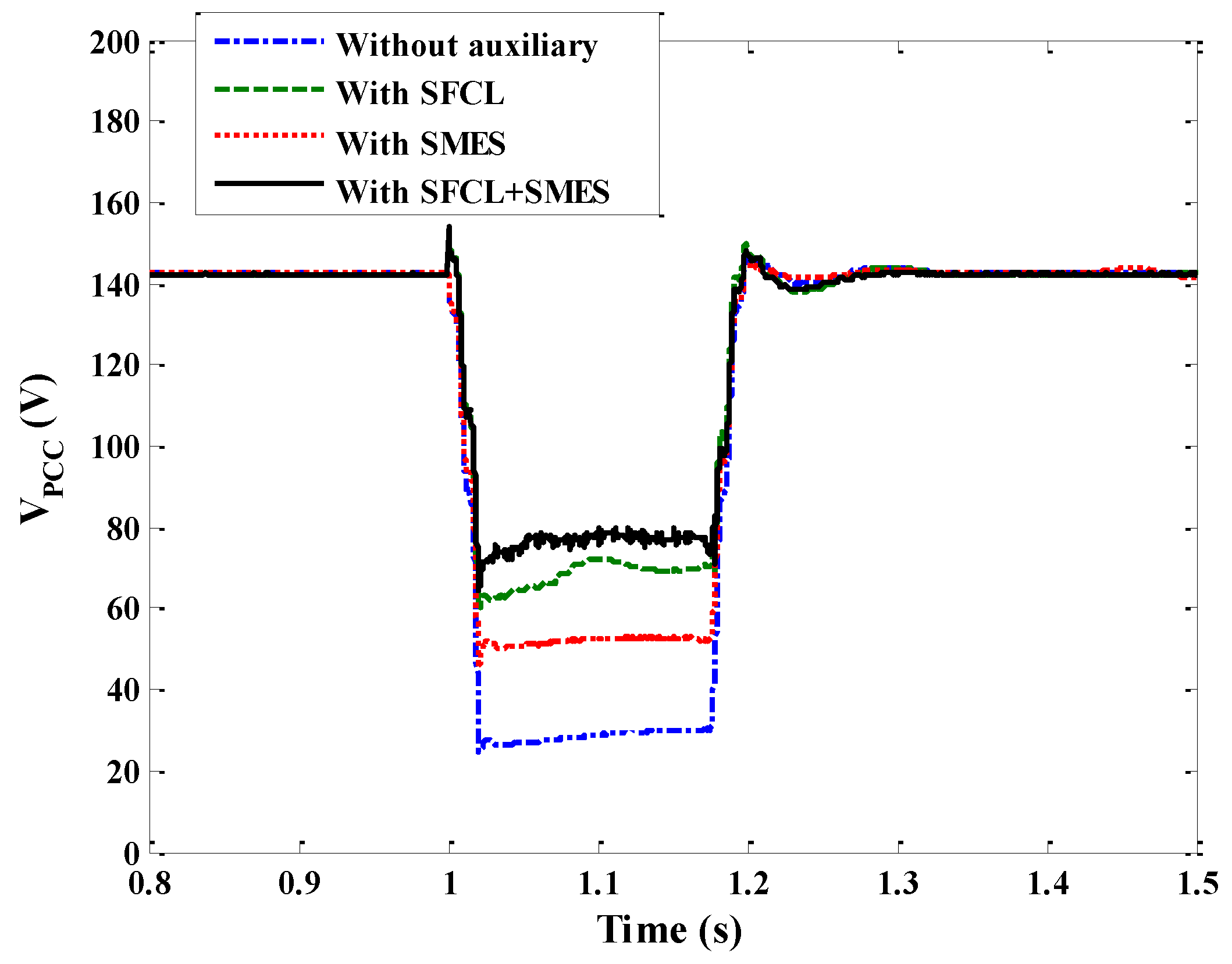
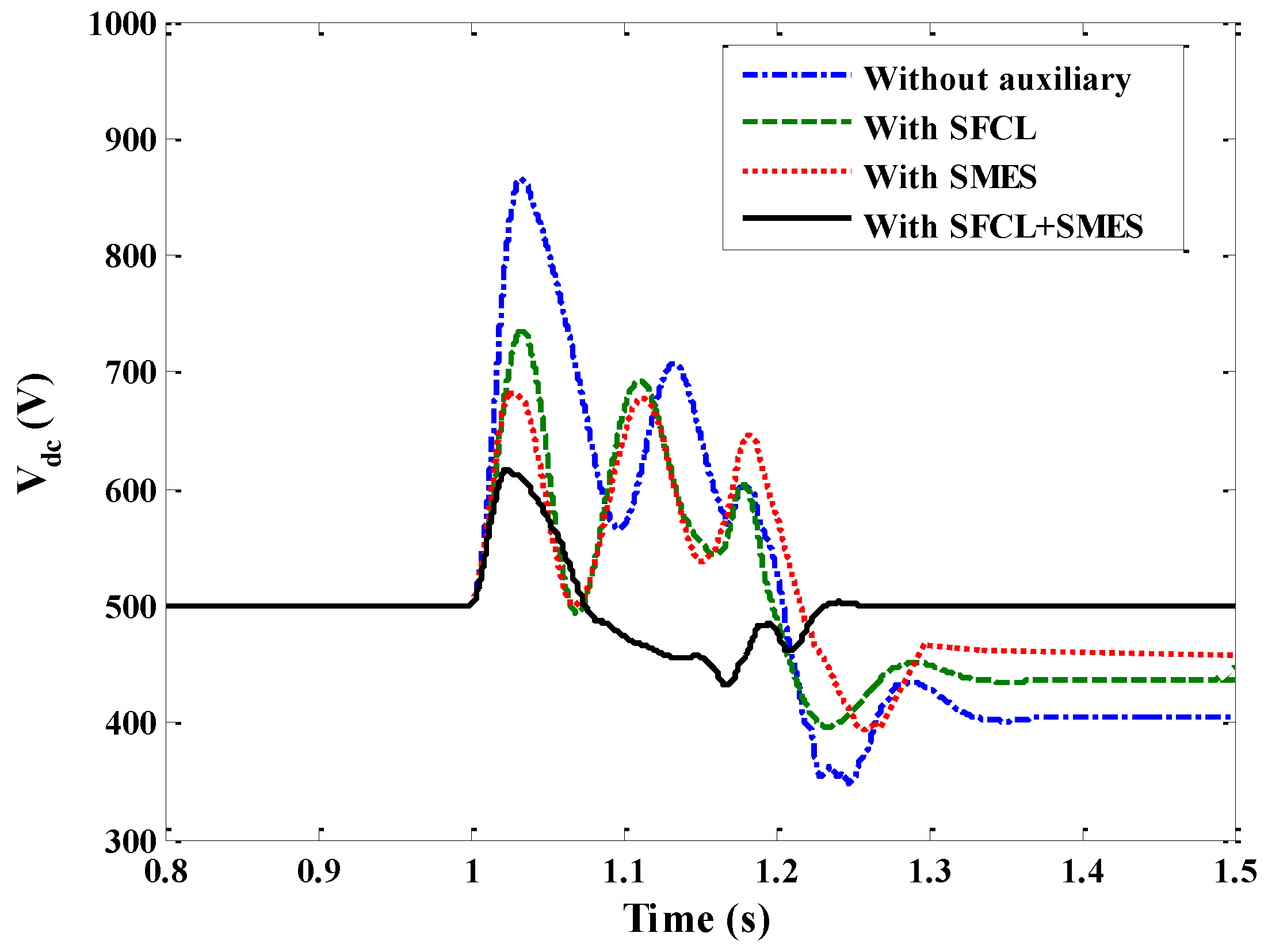

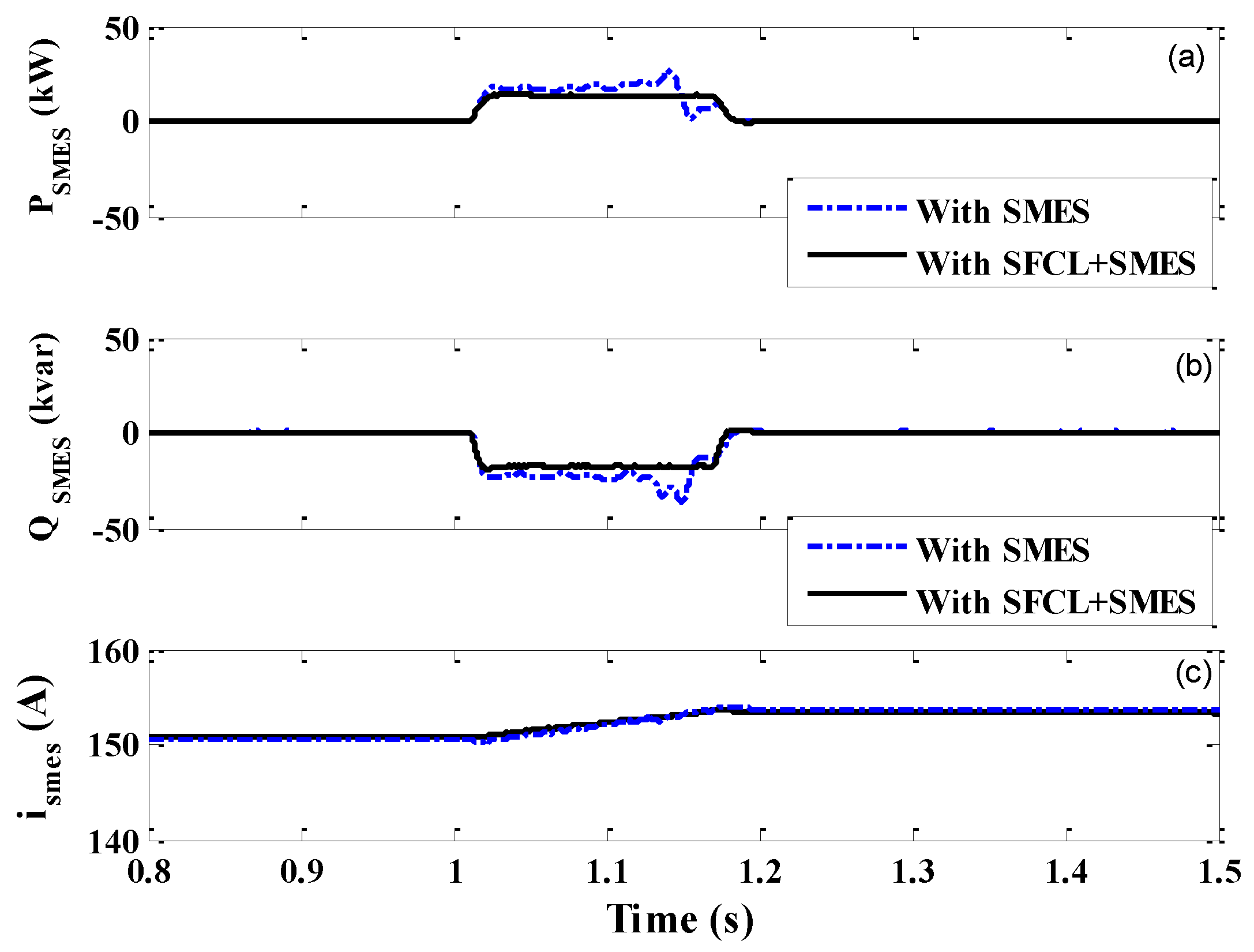

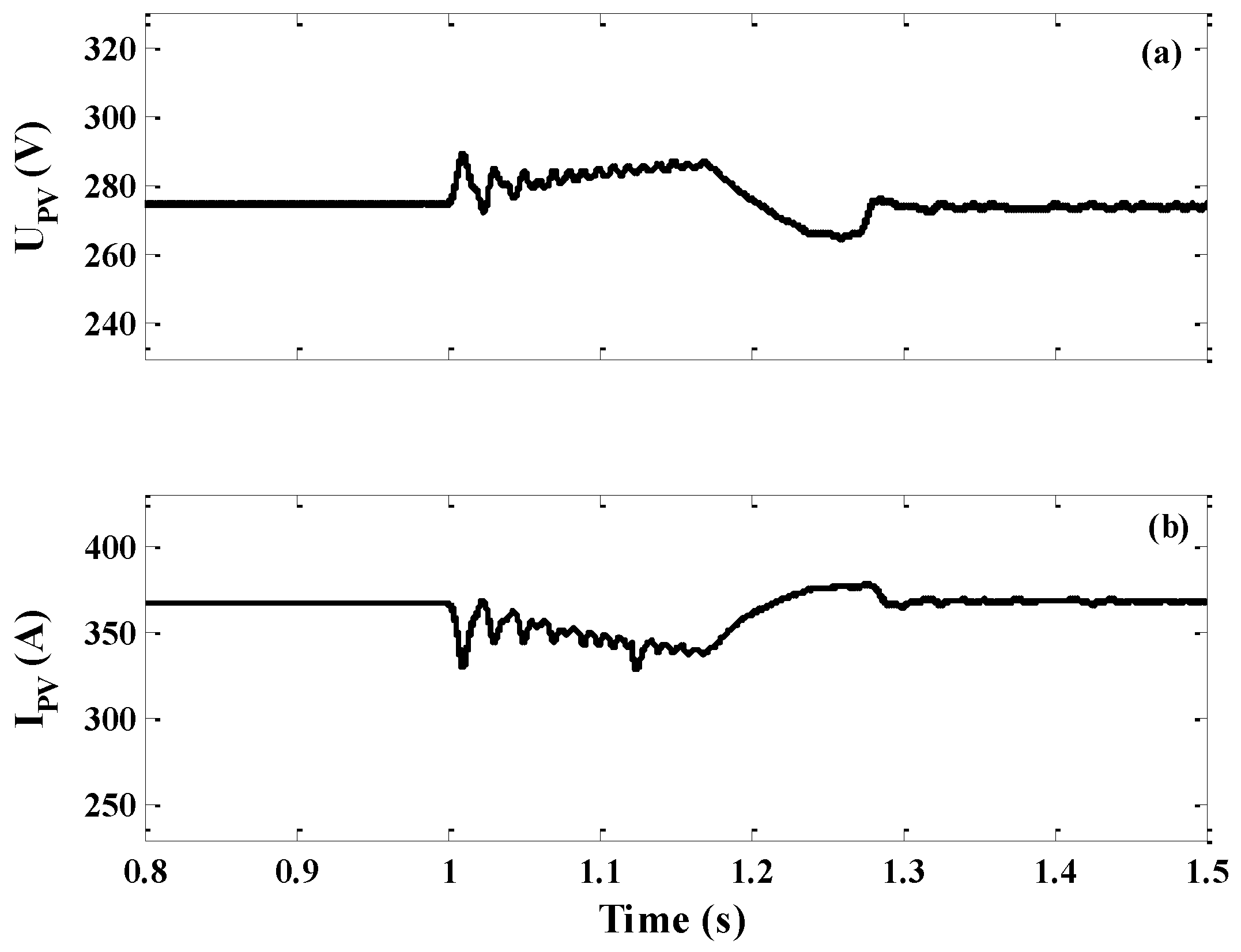
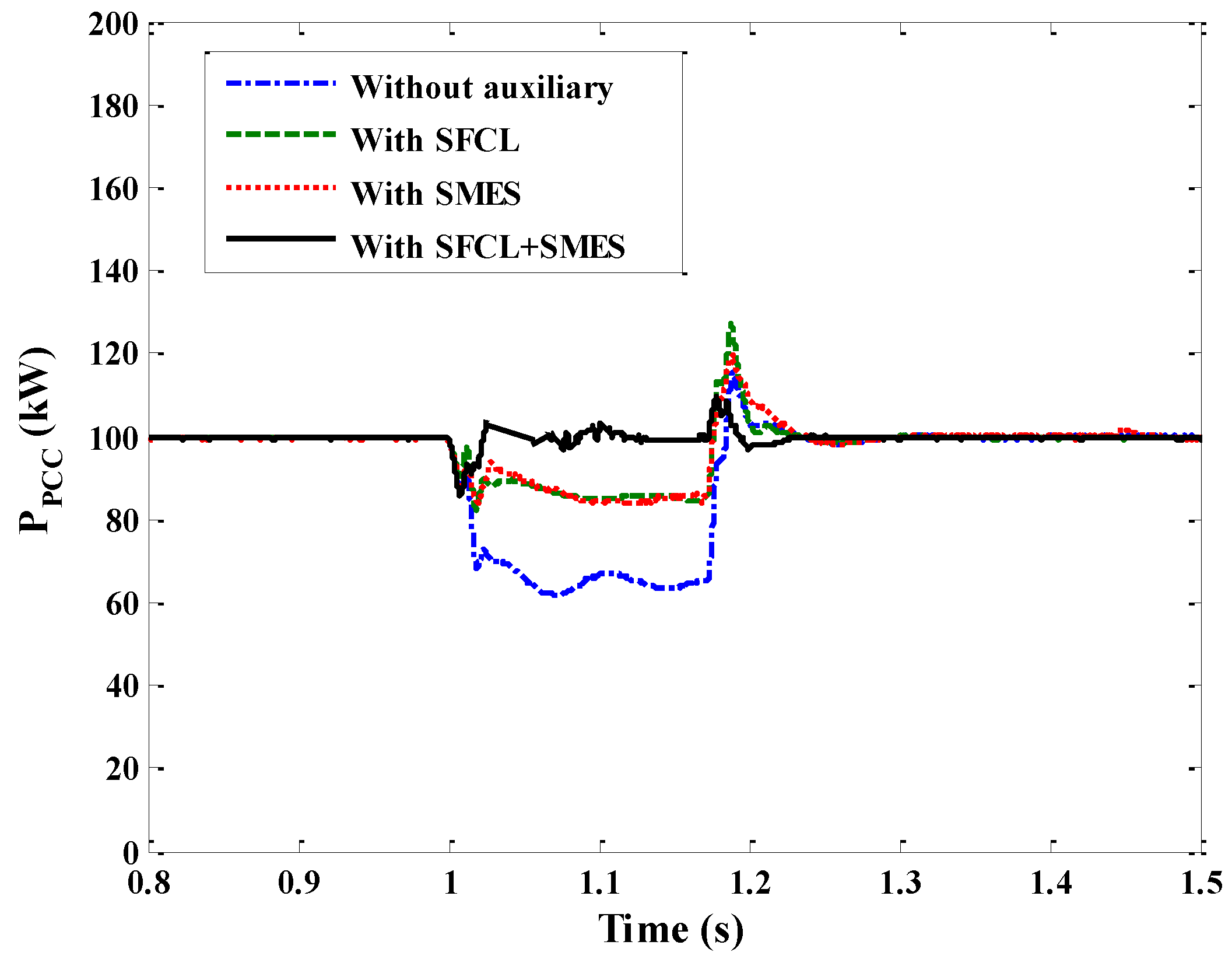

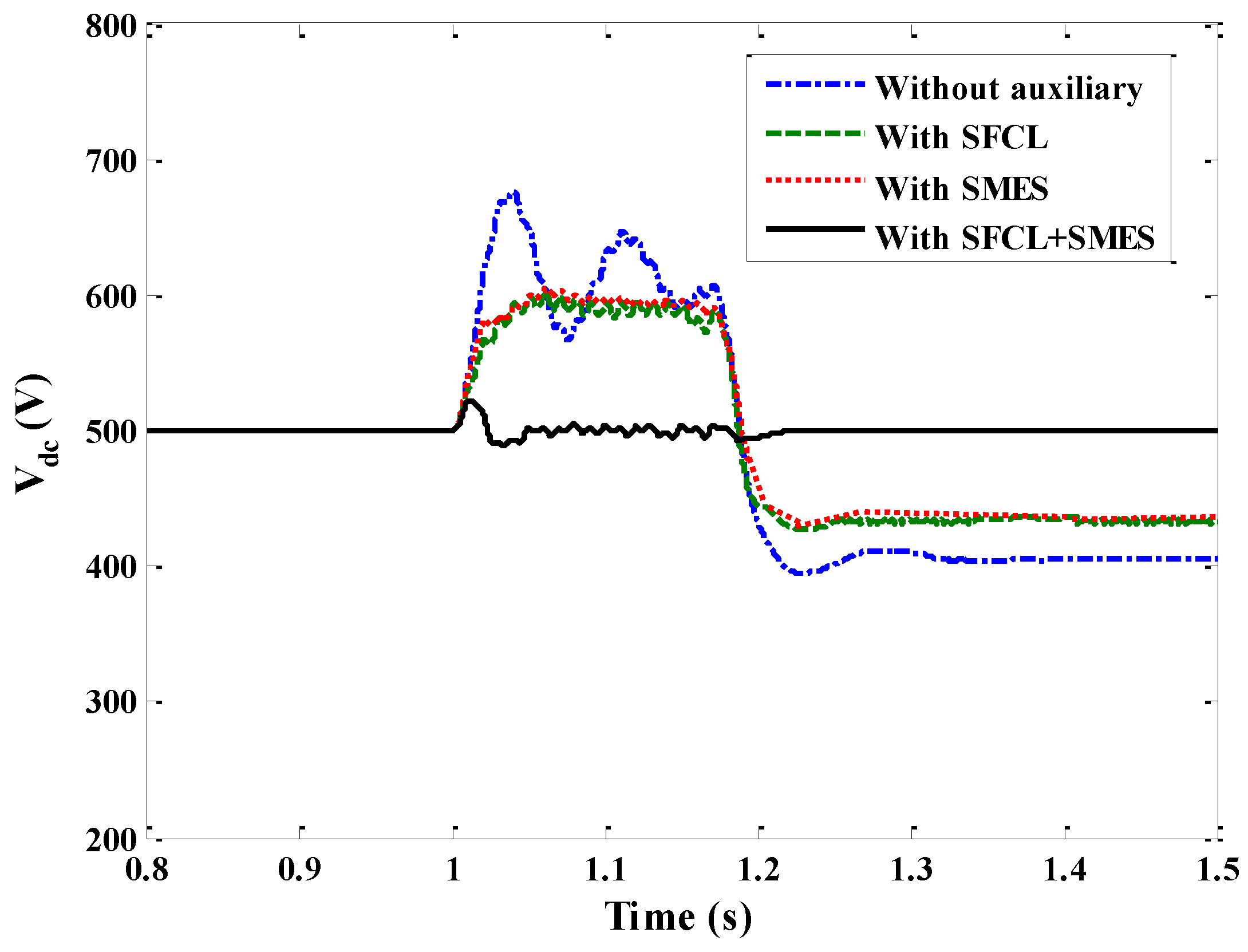
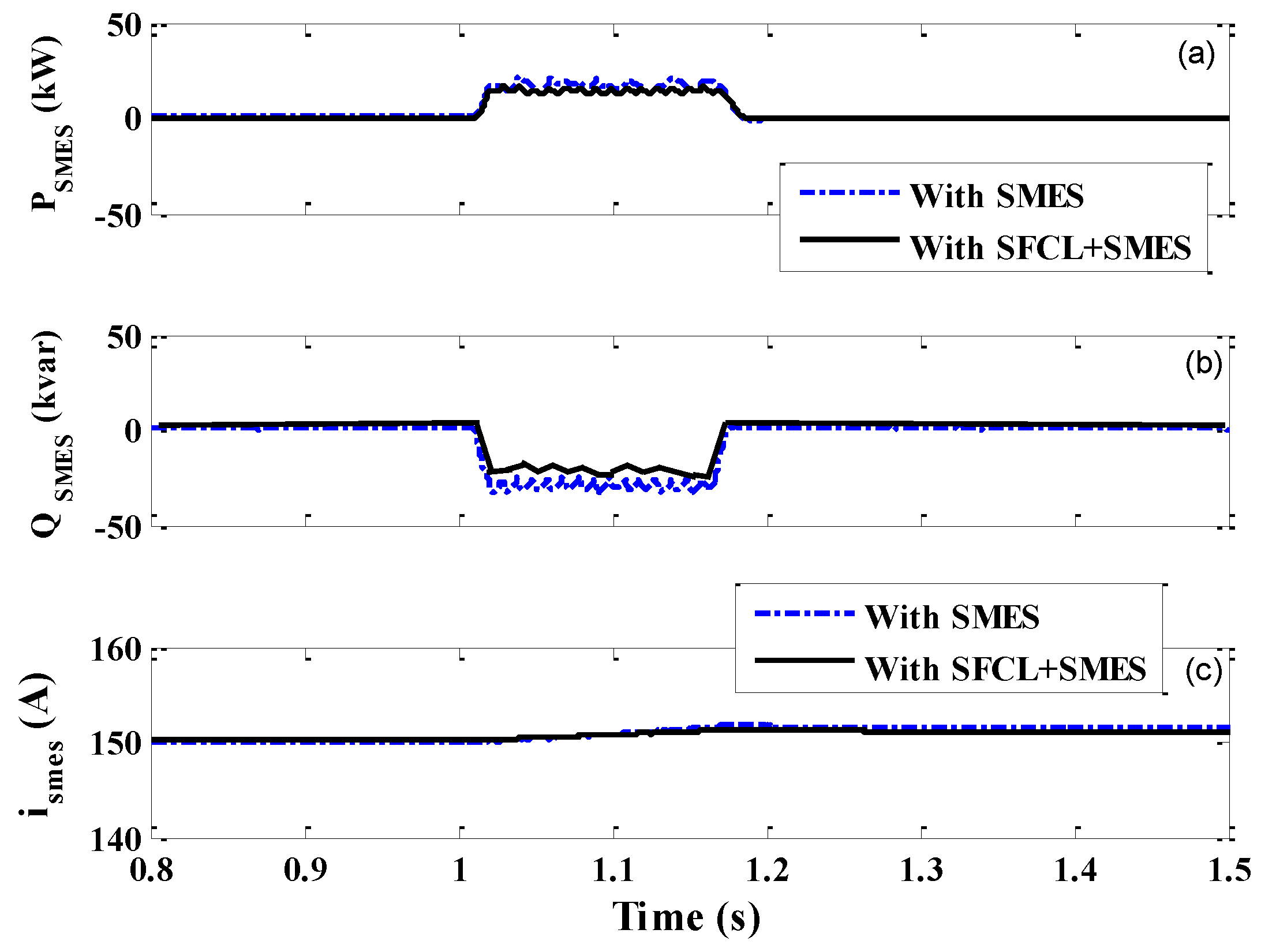
| SFCL | Primary/Secondary/Mutual inductance | 15 mH/15 mH/14.98 mH |
| SC Rsc | 3 Ω | |
| SMES | Inductance/Initial current | 6 H/150 A |
| DC bus/Capacitor | 800 V/ 7500 µF | |
| PV Generation System | Rated active power | 100 kW |
| DC-link voltage/Capacitor | 500 V/ 100 µF | |
| Boost converter frequency | 5 kHz | |
| VSI’s AC side | 260 V/ 50 Hz | |
| Set-up transformer | 260 V/10.5 kV, 200 kVA |
© 2017 by the authors; licensee MDPI, Basel, Switzerland. This article is an open access article distributed under the terms and conditions of the Creative Commons Attribution (CC-BY) license (http://creativecommons.org/licenses/by/4.0/).
Share and Cite
Chen, L.; Chen, H.; Yang, J.; Yu, Y.; Zhen, K.; Liu, Y.; Ren, L. Coordinated Control of Superconducting Fault Current Limiter and Superconducting Magnetic Energy Storage for Transient Performance Enhancement of Grid-Connected Photovoltaic Generation System. Energies 2017, 10, 56. https://doi.org/10.3390/en10010056
Chen L, Chen H, Yang J, Yu Y, Zhen K, Liu Y, Ren L. Coordinated Control of Superconducting Fault Current Limiter and Superconducting Magnetic Energy Storage for Transient Performance Enhancement of Grid-Connected Photovoltaic Generation System. Energies. 2017; 10(1):56. https://doi.org/10.3390/en10010056
Chicago/Turabian StyleChen, Lei, Hongkun Chen, Jun Yang, Yanjuan Yu, Kaiwei Zhen, Yang Liu, and Li Ren. 2017. "Coordinated Control of Superconducting Fault Current Limiter and Superconducting Magnetic Energy Storage for Transient Performance Enhancement of Grid-Connected Photovoltaic Generation System" Energies 10, no. 1: 56. https://doi.org/10.3390/en10010056







